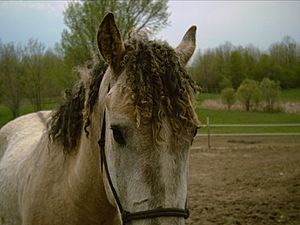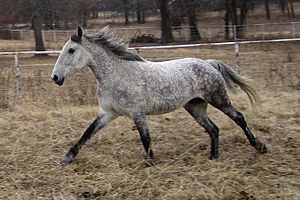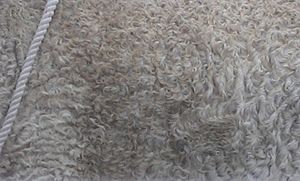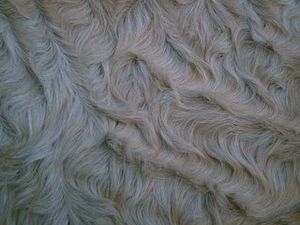Curly Horse facts for kids

Curly horse
|
|
| Distinguishing features | Curly coat, mane, tail, fetlocks and inner ear hair |
|---|---|
| Alternative names | American Bashkir Curly, North American Curly Horse, and American Curly Horse |
| Country of origin | North America |
| Common nicknames | Curly |
| Horse (Equus ferus caballus) | |
A Curly is a special breed of horse. Curlies are also known as Bashkir Curlies or North American Curly Horses. They come in many sizes, colors, and body types. But all Curlies have a unique gene that gives them a curly coat of hair.
Contents
What Makes Curlies Special?
Curlies are known for being calm, smart, and friendly. They are easy to train and have a tough body. They also have amazing stamina, which means they can work or run for a long time. Most Curlies love being around people. They are not easily scared and tend to think things through. Curlies are very dependable and work hard.
Their Unique Curly Coat
The gene that gives Curlies their curly hair is most noticeable in winter. Some Curlies have just a little curl, like inside their ears or on their lower legs. Their mane and tail might be kinky. Other Curlies have curls all over their body. Their mane can look like dreadlocks, and they might even have curly eyelashes!
There are also "Extreme" Curlies with very tight curls. But when they shed their winter coat for summer, they can lose almost all their hair! In summer, their coat usually has a slight wave, but it's not as curly as in winter.
Sometimes, a purebred Curly horse might not have any curls at all. These are called "smooth coat" Curlies. This happens because of how the curly gene is passed down.
Curlies have manes that naturally split. People usually don't braid or clip their manes for shows. Curlies are often chestnut brown, but you can find them in almost any color. This includes black, grey, appaloosa patterns, and pinto patterns. They can also be dilute colors like buckskin, roan, grulla, and cremello.
Caring for their curly hair is easy. Most people choose not to comb the mane. This helps keep the curls. Manes are often trimmed to stop them from getting tangled. Tails can be combed. Some people collect the hair that Curlies shed in spring. This hair is then used for spinning by the ICHO Fiber Guild. The money raised helps with Curly horse research.
Are Curlies Hypoallergenic?
Many people say Curlies are the only hypoallergenic horse breed. This means that most people who are allergic to horses can be around Curlies without having an allergic reaction. Scientists think a certain protein might be missing from Curly horse hair. This protein might be what causes allergies in people. However, this study was never officially published. Groups that support Curlies are working to fund more research on this topic.
How Curlies Are Built
Curlies have a special long stride and strong way of moving. They have tough hooves, strong bones, and amazing endurance. Most Curlies are between 14 and 16 hands tall. (A "hand" is a way to measure a horse's height, about 4 inches). Some Curlies can be as small as Miniature horses or as large as Draft horses.
Where Did Curlies Come From?
The exact history of the Curly horse is still being studied. There are different ideas about where they came from. This sometimes causes confusion about what the breed is called. Some people prefer "Bashkir Curly," while others prefer "North American Curly."
One idea is that the breed came from Iberian horses. It has been noticed that when Curlies are crossbred with other horses, their foals often have curly hair. This suggests that the curly gene is strong and often passed on.
Many theories explain how the American Curly developed. The first time Curly horses were written about was in the early 1900s. This happened in Eureka, Nevada, by a rancher named John Damele and his sons. Wild horses, called Mustangs, were common. But horses with curly coats were unusual.
Years later, the Dameles caught a Curly horse. They trained it to ride and sold it. This began their connection with the breed. In 1932, a very harsh winter hit the area. In the spring, the only horses that survived were the Curlies. The Damele family saw how tough these horses were. They decided to add more Curlies to their herd.
After another harsh winter in 1951-1952, the Dameles became serious about breeding these horses. They found their first main breeding stallion. He was a two-year-old chestnut horse from a mustang herd. They named him Copper D. The Dameles wanted to make their horses even better. So, they added some other horse breeds to their herd. They used stallions like Ruby Red King, a Morgan, and Nevada Red, an Arabian. These two stallions had many offspring for the Dameles. Their bloodlines are found in hundreds of Curly horses today.
Groups That Support Curlies
There are several groups that help register and promote Curly horses:
- The American Bashkir Curly Registry (ABCR) started in 1971. It had only 21 horses at first. By 2005, there were over 4,000 Bashkir Curlies, mostly in North America. This is the oldest Curly Registry. They only register horses whose parents are already registered with ABCR.
- The International Curly Horse Organization (ICHO) began in 2000. By 2006, it had over 800 horses registered. Horses in this group are called "North American Curly Horses." ICHO registers horses based on their curly traits, not just their family tree.
- Curly Sporthorse International (CSI) started in 2003. This group helps promote Curly horses that are good for sports. CSI supports Curly owners and breeders. They help improve breeding, promotion, and marketing. They also give awards for performance.
- Canadian Curly Horse Association (CCHA) formed in 1993. This group focuses on community events and sharing knowledge about the Curly horse in Canada.
What Are Curlies Used For?
Curlies are eye-catching in the show ring. But they also have the movement, endurance, and spirit to do well in competitions. Curlies have competed at high levels in dressage (a type of horse training) and show jumping. Others are reliable and patient teachers for riders who compete on weekends.
Curlies are usually quiet and level-headed. This makes them great first horses for supervised beginner riders. Curlies have helped horse-allergic riders learn to ride and become more advanced. They are also used for combined driving (pulling carts), western riding, working on ranches, and as trail horses. They also make good companions for other horses.
Some Curlies have been crossbred with gaited horses. About 10% of these crossbred horses will do special gaits. These include the running walk, fox trot, or the stepping pace, also called the "Curly shuffle." Curlies are not typically used for racing or high trotting shows.




